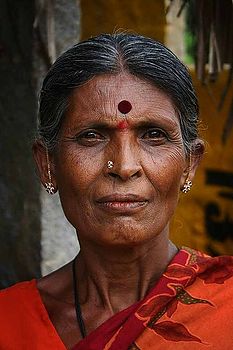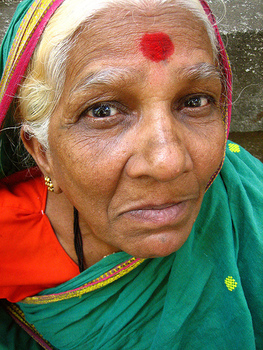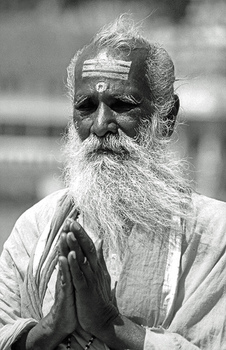Bindi
Bindi comes from the Sanskrit word bindu meaning „a drop, a small particle“. Bindi is a forehead decoration worn by women in India. Depending on the language different names are used for bindi. Pottu is used in Tamil and Malayalam, Tilak in Hindi, Bottu or Tilakam in Telugu, Bottu or Tilaka in Kannada and Teep ("a pressing") in Bengali.
 Bindi - Indian forehead decoration
Bindi - Indian forehead decoration
Usually the women having bindi are married. Still, there are single women and even children who also have bindi.
The part of forehead with bindi is believed to be the sixth chakra, ajna, the place of "concealed wisdom". This chakra is the exit point for kundalini energy. Some believe that the bindi retains energy and strengthens concentration.
Bindi is usually a red coloured dot. But It can be made in other colours like yellow, orange and so on. Shape and size of bindi vary too. Instead of a traditional dot a piece of jewelry can also be worn.
 Typical red coloured bindi
Typical red coloured bindi
Bindi is made of red sindoor or vermilion powder. Vermilion (or sometimes vermillion) is an orange-red pigment which is traditionally derived from the powdered mineral cinnabar (cinnabarite).
If the woman has both bindi and a vermilion mark on the parting-line of hair (also called mang) just above the forehead, it a sign that she is married.
In some cases bindi is also made of kumkum. Kumkum is a powder made of turmeric (Curcuma longa) or saffron . The turmeric powder mixed with a bit of lime changes its rich yellow colour into a red one.
 Brahman
Brahman
Forehead marks are worn by some Indian men too. But they do not have the meaning of those worn by women. They can be worn on a daily basis but most of can be seen on men during different religious festivities. They differ according to the caste system. There are - Brahman Tilak (Urdhapundra), Kshatriya Tilak (Tripundra), Vaishya Tilak (Ardhachandra) and Shudra Tilak (Partal).